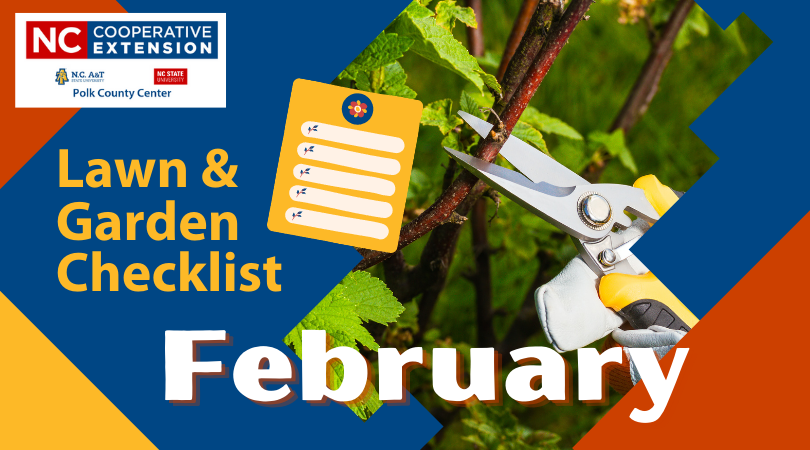Polk County Lawn & Garden Checklist for February
go.ncsu.edu/readext?839331
en Español / em Português
El inglés es el idioma de control de esta página. En la medida en que haya algún conflicto entre la traducción al inglés y la traducción, el inglés prevalece.
Al hacer clic en el enlace de traducción se activa un servicio de traducción gratuito para convertir la página al español. Al igual que con cualquier traducción por Internet, la conversión no es sensible al contexto y puede que no traduzca el texto en su significado original. NC State Extension no garantiza la exactitud del texto traducido. Por favor, tenga en cuenta que algunas aplicaciones y/o servicios pueden no funcionar como se espera cuando se traducen.
Português
Inglês é o idioma de controle desta página. Na medida que haja algum conflito entre o texto original em Inglês e a tradução, o Inglês prevalece.
Ao clicar no link de tradução, um serviço gratuito de tradução será ativado para converter a página para o Português. Como em qualquer tradução pela internet, a conversão não é sensivel ao contexto e pode não ocorrer a tradução para o significado orginal. O serviço de Extensão da Carolina do Norte (NC State Extension) não garante a exatidão do texto traduzido. Por favor, observe que algumas funções ou serviços podem não funcionar como esperado após a tradução.
English
English is the controlling language of this page. To the extent there is any conflict between the English text and the translation, English controls.
Clicking on the translation link activates a free translation service to convert the page to Spanish. As with any Internet translation, the conversion is not context-sensitive and may not translate the text to its original meaning. NC State Extension does not guarantee the accuracy of the translated text. Please note that some applications and/or services may not function as expected when translated.
Collapse ▲For more info, help, and advice on these or other lawn and garden topics, contact your Polk County Extension Director, Scott Welborn.
February is the best time of year for major pruning and shaping of most trees and ornamental shrubs. At this time you can cut overgrown shrubs way back to rejuvenate them. You can also remove limbs from trees–but never top a tree!
Spring-Flowering Shrubs
Spring-flowering shrubs bloom on last year’s wood and should not be pruned until after flowering (if you want to preserve the bloom for this year). These include: Azaleas, Rhododendrons, Forsythia, Spirea, Flowering Quince, Kerria, Pieris, Weigela, Abelia, Oakleaf and Macrophylla Hydrangeas, Beautyberry, Clethra, and Vitex. If you desire to cut these shrubs back substantially, you can prune them in February but be willing to forego a bloom for this year.
Summer-Flowering Shrubs
These bloom on this year’s wood, as well, and should be pruned before new growth starts. On deciduous shrubs, 1/3 of the oldest shoots should be cut back to the ground. Summer- flowering Buddleia Davidii should have all shoots cut to 8-12” from the ground. Crape myrtle trees may be pruned at this time but try not to commit “crape murder” by topping.
Overgrown Established Plants
Plants Plantings of old established plants like Holly, Cleyera, Japanese Holly, Pittosporum, Ligustrum and similar broad-leaf evergreens can be cut back to 15-24” from the ground if you want to rejuvenate them.
Conifers
Pine, Junipers, Fir, Spruce, Yew and Arborvitae will not withstand heavy pruning because most conifers don’t have latent buds below the foliage area and do not readily produce adventitious buds. If a branch is cut back past the foliage area, it will not re-foliate. The best time to prune conifers is just after the new growth is completed, usually in late spring or early summer. Encourage bushier growth on pines by pinching out the new candles. Hemlocks are the exception to the rule. They will tolerate heavy pruning and are sometimes used for hedge plants.
These are useless in sealing pruning cuts and may actually do harm to the tree! Avoid them.
Ornamental grasses should be cut back before new growth starts. Mow Liriope (Monkeygrass) to remove last year’s unsightly foliage. Ornamental grasses may be divided now.
Apply a dormant oil spray to fruit trees and ornamentals for control of overwintering insects and eggs. Do not apply to broadleaf evergreens when freezing temperatures are expected.
Control Wild Garlic with 2, 4-D Amine. Add a few drops of dishwashing detergent as a surfactant to help the herbicide adhere to the narrow leaves. Spray in late February/early March, and again in late August. Control may require two years of persistence, spraying in both growth seasons.
Thin bush roses to 3-5 good strong canes and shorten canes to 15”. Prune climbers after they flower in early summer. Shrub Roses such as the popular variety “Knockout” need little (if any) pruning but can be pruned hard if they are overgrown.
During a rainy winter period our fescue lawns can look pretty poor. You will notice yellowing and browning of the lawn due to the cold and wet conditions. You can help to mitigate this by applying a nitrogen fertilizer during warm periods of the winter. You will also want to apply a fungicide in early March to ensure all the water doesn’t lead to out of control fungal problems in the spring.
Around the last week of February, in Polk County, you can usually safely plant CABBAGE, LETTUCE, PEAS, RADISHES, SPINACH, CARROTS, ONIONS, TURNIPS, BROCCOLI, CAULIFLOWER, and BEETS. However, if temps drop below 26 degrees, definitely provide protection for your transplants.
NOTE: The use of brand names in this publication does not imply endorsement by the North Carolina Cooperative Extension Service of the products or services named nor discrimination against similar products or services not mentioned.





